
Travel Tour Scotland
All About Scotland
Golf Transport + Airport Transfer Service

South Street St Andrews
South Street is where you will find St Mary's Quad
and the Gregory meridian. The oldest part of the University
and the town gate (west port). Madras College Blackfriars Chapel ruins, the Town Hall and many other historic sites.
The West Port
South Street St Andrews
The West Port was built circa 1580 and is the only gate in its original position left in Scotland. It does not seem to be part of a town wall that would have been closed in case of invasion by the English, The gate was extensively refurbished in 1843. Above the centre of the arch is the St Andrews Coat of Arms


Gavin Douglas 1474 - 1522
City Road St Andrews
Through West Gate on corner of street opposite
Gavin Douglas was born in
Tantallon Castle East Lothian in 1476.
He was 3rd son of Archibald "Bell the Cat"
Douglas 5th Earl of Angus
his house stood near this spot.
A student of St Andrews University, he was a poet noted for his "Palice of Honour" and for his "Eneados" a translation of Virgil's "Aeneid" into Scots.
He was Dean of St Giles Edinburgh in 1501,
the Bishop of Dunkeld in 1515.
Died 1522 London of the Plague.
His Coat of Arms
no longer visible on the plaque.

Madras College
South Street St Andrews
Madras College first opened in 1833 and takes its name from founder the Rev. Dr Andrew Bell and the educational system he devised.
see his plaque beside Blackfriars Chapel.

Blackfriars Chapel
South Street St Andrews


Blackfriars Chapel was built in 1525 and damaged by fire in 1547 and destroyed in 1559 by a Protestant during the reformation.
The structure on South Street is all that remains.
Charles Lapworth Plaque
South Street St Andrews
Charles Lapworth was a teacher at Madras College 1875 – 1881.
A self-taught Geologist was the founder of a new geological time (The Ordovician Period)
He became a Professor of Geology in 1881 at Birmingham University.
Plaque Reads:
CHARLES LAPWORTH, LLD, FRS, 1842-1920
Between 1875 and 1881 Lapworth was a teacher of English at Madras College. In his spare time he studied the Rocks of extinct creatures called Graptolites to help unravel the complexities of these ancient rocks. As a result of his careful studies, he proposed anew division of geological time, The Ordovician Period that is now recognised and used internationally. He also correctly interpreted the Moine Thrust Fault Zone in the North West Highlands of Scotland as amass of older rocks pushed over younger ones, an idea which at the time conflicted with orthodoxy. He left St Andrews in 1881 to become Professor of Geology at the University of Birmingham.

Dr Andrew Bell Plaque
South Street St Andrews
Dr Bell was born in South Street St Andrews in 1753
he died in 1832. Son of Bailie Bell, Andrew was Founder of the Madras College in 1833 he pioneered
the Madras System of Education.
Teaching system which went worldwide,
where older children taught younger children.
Plaque reads:
The Reverend Dr Andrew Bell 1753 – 1832
An educational reformer and philanthropist. He was born in
St Andrews. It was while serving in Madras in India that he developed a form of schooling where
the older pupils taught the younger.
When he returned he introduced his “Madras” or monitorial system as an economical form of mass education. The idea spread, Madras Schools appearing in Canada and Australia. Among the other local benefactions was the Bell fund for the benefit of St Andrews. He ended his career as Prebendary of Westminster Abbey. Where he is buried.

Dr John Adamson's House
South Street St Andrews


Dr John Adamson 1809 - 1870 lived here 1845 - 1865
He was a Physician and pioneer photographer.
In 1841 he too the first calotype portrait.
He also taught his brother Robert and Thomas Rodger the technique and art of photography.
Holy Trinity Church
South Street St Andrews
The Holy Trinity Church originally stood close to St Andrews Cathedral
and was built in 1144.
It has been in its present position in South Street since 1412.
Originally served by Roman Catholic priests
it changed with the Reformation in 1559
to Protestant and Episcopalian priests.
Since 1689 the ministers have been Presbyterian.
The Tower and two interior arches are the only original parts of the church from 1412 that remain.
1907 the church was demolished and rebuilt to the previous medieval church’s footprint and rededicated on St Andrews Day in 1909.

The Sharp Aisle
The Sharp Aisle, contains the tomb and monument to Archbishop Sharp (1618-1697),
Sharpe was murdered by Covenanters at Magus Muir 1697.
The Great East Window
Dated from 1910
The Good Physician
Dated from 1890 is the only surviving window prior to the reconstruction of the church in 1909.
John Knox Porch
In 1547 Holy Trinity was the scene of the first public sermon
of the famous reformer, John Knox.
He also preached in Holy Trinity in 1559, instructing residents of St Andrews to purge the city of "monuments of idolatry". Inspired by Knox's the local population rejected Catholicism, tore down statues and altars, and sacked St Andrews Cathedral.

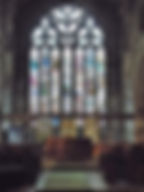
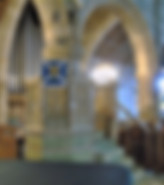
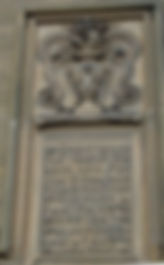
St Andrews Town Hall
South Street St Andrews

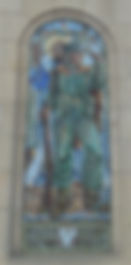
St Andrews Town Hall
St Andrews Town Hall erected in 1858 for municipal and public purposes
Sir Hugh Playfair became Provost of St Andrews in 1842. He was knighted for services to the town and University and received an honorary LLD in 1856
Polish Soldier Mosaic Memorial St Andrews
The mosaic on the town hall of St Andrews commemorates the large number of Polish troops stationed in the area after the capitulation of Poland in 1939.
Robert Burns Club Plaque
South Street St Andrews
St Andrews Burns Club Plaque
Can be found on what was the Royal Hotel where the club was founded
on 25th January 1869.
13 in the Robert Burns World Federation
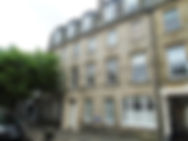


Hamish McHamish Statue
Logies Lane St Andrews

Hamish McHamish was a ginger cat
(aged 15 years)
that lived in St Andrews Scotland.
He became am international star when a book entitled Hamish McHamish of
St Andrews: Cool Cat About Town was published. Hamish a social media star
with his own Facebook page and Twitter account @Hamish_McHamish.
A nomadic cat that was looked after by many of the residents of St Andrews.
Once owned by Marianne Baird.
Bailie Bell's House and Foundry
South Street St Andrews

In 1620 Edward Raban came to
St Andrews and set up a printing press in a building on the corner of North Street and Church Street.
This was later demolished by Bailie Bell in 1740 so he could build his house. This house is where his son was born in 1753 (Andrew). Andrew was to found Madras College and the "monitorial system" of education.
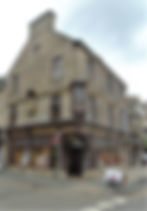
Royal Coat of Arms Tablet
South Street St Andrews
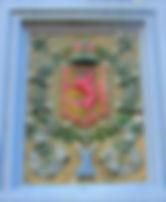
George Martine of Claremont
South Street St Andrews
George Martine of Claremont 1635 -1712,
Lived in South Street. He was a lawyer commissary clerk of St Andrews and author of the
First history of the Archbishopric "Reliquiae Divi Andreae"
‘The State of the Venerable See of St. Andrews’. His work was written in 1683, but not published till 1797.

Dr George Martine (The Younger) FRS 1700 - 1741
Dr George Martine was a physician, surgeon and geologist, who later lived at 56 South Street.
He was the first to make a careful study of heat and scales of temperature, and made the
First estimate -400F, of the absolute zero temperature.
He made the first useful mercury in glass clinical thermometer.
He also at this address in 1730 performed the first Tracheotomy in Britain.
He died of bilious fever during the battle of Jenkins Ear in 1741.
James David Forbes House
South Street St Andrews
James David Forbes was born in Edinburgh 20 April 1809
at 86 George Street.
He was educated at Edinburgh University in 1825. At 19, became a fellow of the Royal Society of Edinburgh, and in 1832
he was elected to the
Royal Society of London.
In 1859 he was appointed successor to David Brewster as principal of the United College of St Andrews, which he held until his death in 1868. It could be said he was first to study the heating of the earth.


James Boswell + Samuel Johnson
South Street St Andrews
This is the site of the Glass Inn
29 South Street
where Boswell and Dr Johnson had supper on the 18th August 1773.
We had a dreary drive in a dusky night to St Andrews where we arrived late. We found a good supper at Glass's Inn.
The Glass Inn survived circa 1830

John Gillespie Sundial
South Street St Andrews
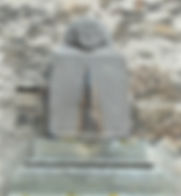
James Gregory's
Meridian Line
South Street St Andrews
South Street St Andrews Scotland
James Gregory was
first Regis professor of Mathematics.
He and two others were the founders of calculus.
He invented the Gregorian telescope.
The Meridian Line was established in 1672.
James Gregory mathematically established a meridian line,
a line circling earth from pole to pole
along which the time is the same
this line passed through St Andrews.
The Greenwich Meridian (GMT) is now
how time is calculated around the world.
St Andrews Meridian / Gregory's Meridian
is 12 minutes behind GMT
Stand with one foot on each side of the line
and you will be standing in both
the Eastern and Western Hemispheres.
You also have an extra 12 minutes
to get to where you are going.


